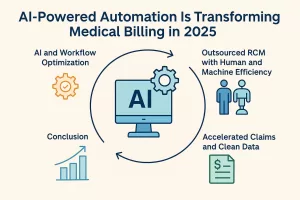In an ever-evolving healthcare landscape, the need for effective financial practices has never been more critical. Medical revenue management plays a vital role in ensuring that healthcare providers can deliver quality care while maintaining financial viability. This blog explores the various components of medical revenue management and how they contribute to enhanced efficiency in healthcare settings.
Understanding Medical Revenue Management
Medical revenue management encompasses the processes and strategies used to ensure that healthcare providers are reimbursed accurately and efficiently for their services. This section will break down the key components involved, from patient registration to billing and collections.
At its core, medical revenue management is about optimizing the financial health of healthcare organizations. It involves meticulous attention to detail, starting with patient registration—where all essential information must be collected accurately to prevent issues down the line. From there, the revenue cycle unfolds through a series of interrelated steps that must be executed swiftly and effectively.
Moreover, accuracy in coding is crucial; it serves as the blueprint for claims submitted to insurers. Errors in this phase not only delay payments but can also lead to costly denials, which is where the importance of training and competency in coding practices becomes apparent. Thus, understanding medical revenue management is not just about the numbers; it’s about cultivating an environment that prioritizes accuracy at every step.
Lastly, collections are where the rubber meets the road. Effective follow-up on outstanding claims can dramatically influence a healthcare provider’s revenue flow. By utilizing best practices and innovative techniques, revenue management teams can turn challenges into opportunities for improvement and empowerment.
The Impact of Revenue Cycle Management on Healthcare Efficiency
A well-structured revenue cycle directly impacts the operational efficiency of healthcare organizations. We’ll explore how streamlining billing processes, optimizing coding practices, and managing denials can minimize delays in revenue and enhance cash flow.
The effectiveness of revenue cycle management hinges on its ability to streamline operations while ensuring accuracy. When billing processes are efficient, it reduces the time taken to send out invoices and collect payments, ultimately leading to improved cash flow. This aspect is incredibly important as it allows healthcare providers to allocate resources more effectively and focus on delivering quality care.
Equally important is the management of denials, which can take a significant toll on a healthcare organization’s financial health. By analyzing denial patterns and implementing strategic changes, healthcare organizations can reduce their denial rates, leading to a smoother revenue cycle. Similarly, optimizing coding practices ensures that claims are submitted accurately and swiftly, further promoting timely reimbursements.
Ultimately, nurturing an efficient revenue cycle translates to not just financial gains but also enhanced patient experiences. When healthcare providers can ensure that their administrative processes are running smoothly, they can devote more attention to the quality of care being delivered, making a positive impact on patient satisfaction.
Key Technologies in Medical Revenue Management
In this digital age, technology plays a pivotal role in medical revenue management. We’ll discuss the various tools and software that can automate and improve revenue cycle processes, making them more efficient and less error-prone.
One of the standout technologies transforming medical revenue management is the implementation of Electronic Health Records (EHRs). These systems not only streamline patient information but also facilitate more accurate coding and billing processes. With EHRs, the likelihood of errors is significantly reduced, allowing for quicker turnaround times in claims processing.
Another essential tool is revenue cycle management software that offers analytics capabilities. By utilizing data analytics, healthcare providers can gain valuable insights into their revenue patterns, identify bottlenecks, and optimize their operations accordingly. This technology helps organizations proactively address issues before they become significant problems, ensuring a healthier bottom line.
Furthermore, automation in billing and collections can alleviate much of the administrative burden on staff. Automated reminders for outstanding payments not only save time but also improve the overall patient experience, as they reduce confusion and help patients understand their financial responsibilities more clearly.
As healthcare continues to evolve, staying updated on advancements in technology will be crucial for those involved in medical revenue management. Embracing these new tools can result in a more streamlined, efficient, and patient-centric approach to revenue cycle management.
Challenges Facing Medical Revenue Management
Despite its importance, medical revenue management faces numerous challenges, from regulatory changes to the complexities of insurance claims. This section addresses these hurdles and offers insights on how to overcome them.
One major challenge in medical revenue management is keeping pace with ever-changing regulations. Regulatory changes can impact coding requirements, billing practices, and compliance measures, making it a constant challenge for healthcare organizations to stay informed. Regular training and education on these updates are vital for maintaining accuracy and compliance.
Moreover, the intricacies of insurance claims can be daunting. Healthcare providers often grapple with varying policies among different insurers, along with complex claim requirements. This is where robust workflows and dedicated staff come into play, ensuring that every claim is not only submitted promptly but also adheres to the specific guidelines laid out by insurers. Inadequate handling of claims can lead to delays and lost revenue, making this an area ripe for improvement.
Finally, staffing issues present their own challenges, as well-trained professionals are essential for the successful implementation of medical revenue management strategies. Retaining skilled personnel who understand the nuances of billing and coding can be difficult, especially in a competitive job market. Organizations might consider investing in training programs and creating a supportive work environment to attract and retain talent.
Case Studies: Successful Implementations
To illustrate the positive effects of effective medical revenue management, we’ll look at real-world case studies where healthcare organizations have successfully improved their financial performance and operational efficiency.
For instance, one prominent hospital implemented a new revenue cycle management software that streamlined their billing process. As a result, they saw a 30% reduction in claim denials within the first quarter of implementation. This improvement not only boosted their cash flow but also allowed them to allocate more resources to patient care.
Another example involves a healthcare practice that adopted comprehensive training for its billing staff. By emphasizing the importance of coding accuracy and employing regular audits, they managed to significantly reduce billing errors. The result was a smoother process for collecting payments, and patient satisfaction ratings increased as a result.
These case studies show that the implementation of effective medical revenue management practices can yield incredible dividends. By investing in technology, training, and streamlined processes, healthcare organizations can navigate the complexities of revenue management successfully.
Wrapping Up the Importance of Medical Revenue Management
As we navigate the complexities of healthcare finance, it is clear that medical revenue management is not just a backend operation; it’s a crucial element that influences the overall efficiency and effectiveness of healthcare delivery. By understanding and implementing robust revenue management strategies, healthcare providers can ensure better patient outcomes while achieving financial sustainability.




